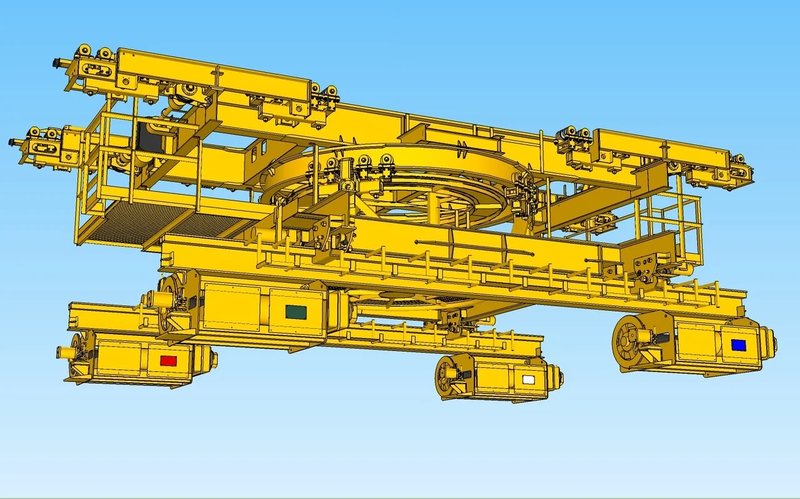 Custom overhead crane with four independent hoists. Designed by CP&A, built by American Crane & Equipment Corporation.
Custom overhead crane with four independent hoists. Designed by CP&A, built by American Crane & Equipment Corporation. CP&A: ‘Is Hiring a Consultant Better Than an Employee?’
Casper, Phillips & Associates (CP&A), based in Tacoma, USA, has seen a rise in demand for its engineering design services, leading to the conclusion that companies have decided that it is better to hire a consultant rather than take on an employee, and is looking further at the benefits of this.
According to Richard Phillips, a mechanical engineer at CP&A, the advantages to companies outsourcing work reduces the cost of a salaried employee and associated taxes and health care with that as well as overhead costs of hiring office space and computers. It could also solve the current problem of labor shortages by finding someone who has the right skills and experience and staff training.
“We don’t want to work for our clients as their employees. Therefore, all our engagements are closed-ended. We determine how many program days are required to do a project, and charge for them, and only them. On successful completion of a project many clients then ask us to help with other projects, continuing the relationship. But, when the final program day comes, we move on to the next project,” said Phillips.
“Our primary goal is to give our clients a competitive advantage over the competition. We are essentially a team that can be quickly hired and laid off without any onboarding costs or severance packages. If I were an employee, I’d strive for the opposite: permanence and dependency.
“Our clients pay nothing into a 401k [profit-sharing plan that allows employees to contribute a portion of their wages to individual accounts] on our behalf, and because we are outside vendors, the typical employee taxes and benefits don’t apply. We have our own computers, software, office space, etc. While we may charge multiples of what typical employees are paid, we can be more cost-effective, because we don’t have any idle time. In other words, our work is 100% put towards production. We don’t bill for typical overhead costs such as estimating, writing proposals, and other non-billable tasks that employees need to perform.
“Another competitive advantage is the fact that we are outside experts. Our clients don’t currently have our capabilities, ideas, experience, or capacity to innovate. And we can be objective and work only at the margins of company politics. We’re not there to fit in, but to help them to stand out.”
Clients who have previously worked with CP&A include National Oilwell Varco’s AmClyde brand, where CP&A provided the structural design of two different Whirley cranes for Ingalls Shipyard. Additionally, CP&A has provided design services to container crane manufacturers such as DHHI, DOOSAN, HHMC, IMPSA, and ZPMC. In the overhead crane industry, CP&A has provided structural and mechanical designs that were built by American Crane & Equipment Corporation.
Phillips added, due to the labor shortage issue, a lot of companies have been looking more into the idea of outsourcing, to see if it’s better than hiring someone full-time.
“There are advantages such as not having to carry out a training period, because we are already experienced engineers. We all know how to work together and although our billing rates may be higher, it’s justifiable because they don’t have to pay for benefits, employment taxes, or pension funds,” he added.
“There’s two ways to do cranes. There’s design-build, where companies hire us to work under the fabricator. And then there’s design, bid, and build, where we design the crane and support the owner in a bidding contract.”
CP&A also specializes in designing cranes that can survive an earthquake, otherwise known as seismic analysis.
The company received many requests from various ports following the earthquake in Turkey on February 6, 2023, when a 7.8 magnitude earthquake rocked the country southeast near the Syrian border. CP&A designed a set of container cranes equipped with an anti-systemic system for DHHI for Asyaport in Turkey that were designed for a D3 level earthquake. A D3 level earthquake is a maximum considered earthquake that is expected to occur once in approximately every 2,500 years.
“When you design a crane for an earthquake, the minimum that you must do is make sure the crane doesn’t collapse. It doesn’t have to be operational, and workers must be able to get off the crane safely. However, BASIS [crane base anti-seismic isolation system] will allow a crane to be operational after a much higher magnitude earthquake, keeping the top structure stable using special friction dampers as the ground shifts beneath it. We set the friction dampers to slip at a certain force so that the friction dampers do not slip during normal operation,” said Phillips.
“It’s an innovative use of technology, which existed before we designed the BASIS system, but only in buildings in certain seismic regions such as Asia, South America, and West Coast USA. We are the first to use friction dampers for base isolation in the crane industry.”









